The BLS employment report shows the unemployment rate ticked up by 0.1 percentage points to 7.9%. The reason for this up-tick is more people participated in the labor force in October. We love economic eye candy at The Economic Populist and this overview graphs many of the statistics from the Current Population Survey of the employment report.

The labor participation rate increased 0.2 percentage points to 63.8%. More people in the labor force is one of the reasons the unemployment rate increased. The labor participation rate is still at artificial lows. For those claiming it's just people retired, we proved that false by analyzing labor participation rates by age.
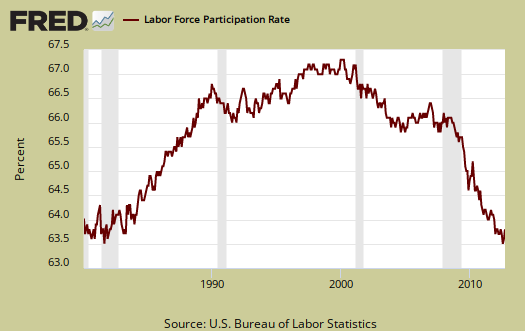
The number of employed increased by 410,000 in a month to a total of 143,384,000 employed people in the U.S. Below is a graph of the Current Population Survey employed.

Those unemployed increased by 170,000 to a new level of 12,258,000. Below is the change in unemployed and as we can see, this number swings wildly on a month to month basis, as we describe here and why you shouldn't use the CPS figures on a month to month basis to determine jobs.

The civilian labor force also jumped up by 578,000 to 155,641,000. Notice in the graph below how many more people are in the labor force than at the start of the 2008 recession. Population increases every month and this post gives details on that increase, while this one describes BLS labor concepts as well as how many jobs are needed just to keep up with the increased population.
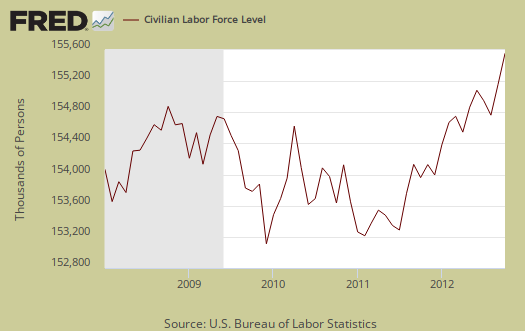
Those not in the labor force shrunk by -369,000 to 88,341,000. Below is the change to show on a month to month basis, the CPS shows quite a bit of variance. We talk about the wild monthly CPS changes in this post.
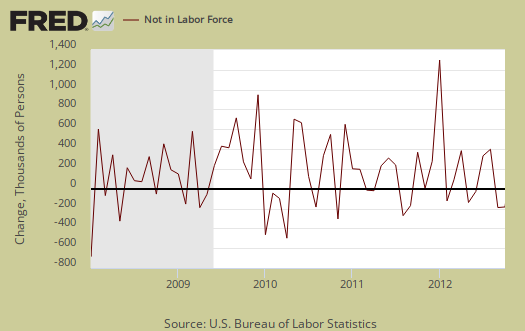
Those considered employed as a ratio to the total Civilian noninstitutional population increased by 0.1 percentage points to stand at 58.8%. Below is a graph since 1980 to show how low this ratio is.

A huge problem with today's labor market is the gross number of working part-time generally. There is a huge number of people who need full-time jobs with benefits who can't get decent career oriented positions. Those forced into part time work decreased by 269 thousand to 8,344,000. That's a hell of a lot of people stuck with part-time hours who need full-time work.

Below is a graph of forced into part-time because they got their hours cut as a percentage of the total employed. This is known as slack work conditions and dropped by -304,000 people in October. Below is a graph of forced part-timers due to slack work conditions as a percentage of the civilian labor force. We think this graph is a recession economic indicator, and notice the slope matches strongly the gray recession bars of the graph. The percentage of people in working part-time due to slack economic conditions has stayed extremely high since the start of the Great Recession, even while declining this month.
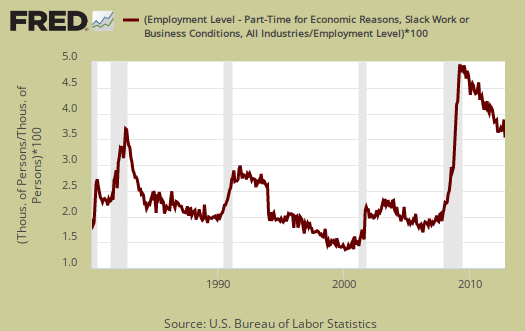
U-6 is a broader measure of unemployment and includes the official unemployed, people working part-time hours because that's all they can get and a subgroup not counted in the labor force but are available for work and looked in the last 12 months. Believe this or not, U-6 still leaves out some people wanting a job who are not considered part of the labor force. U-6 ticked down 0.1 percentage points to 14.6%.
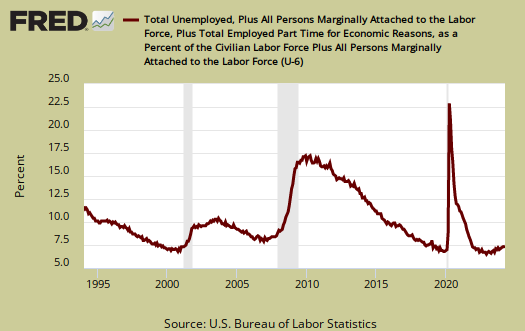
The long term unemployed, or those unemployed for 27 weeks and over, increased by 158 thousand to an astounding 5,002,000 people. The long term unemployed are the crisis of our time and this figure just isn't decreasing. The long term unemployed are 40.6% of the total unemployed, a figure that just has not budged....for years now.
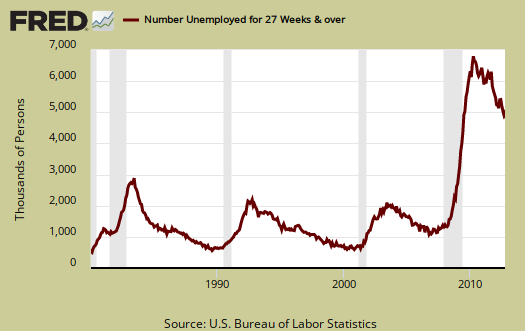
The marginally attached are people not in the labor force because they have not looked for a job in the last month, but have looked for a job in the last year. This number has ballooned since 2007 and not returned to pre-recession levels. The graph below is the number of people considered marginally attached to the labor force, currently at 2.433 million.

Discouraged workers are people, not counted as part of the civilian labor force, who not only want a job, but also looked for one in the last year. These people aren't job hunting now because they believe there are no jobs out there. Below is the graph of discouraged workers, currently at 813 thousand and are a subset of the marginally attached.

One of our favorite statistics from the CPS survey is how many people who are considered not in the labor force, want a job now. It is a direct survey question from the CPS. The survey asks people who are not being counted in the unemployment statistics and official unemployment rate if they want a job. The number who answered yes currently stands at 6,587,000. That's an astounding number of people not counted who report they actually want a job. This figure includes the discouraged workers and marginally attached, graphed above.

The average length of unemployment increased from 39.8 weeks to 40.2 weeks, which is a negative sign, just absurdly long to be unemployed.

The median time one is unemployed, which means 50% of people have gotten a job in this amount of time, also increased significantly from 18.5 to 19.6 weeks.

We hope you enjoyed this graph-o-rama of the current population survey statistics. Check back for we will be reviewing the payrolls survey as well as zeroing in on other statistics for insight and analysis into our never ending, beyond belief, pathetic employment situation.

Recent comments